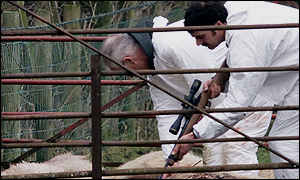
Licensed slaughtermen at work
'My airfield is a mass grave'
Thursday, 29 March, 2001, 08:31 GMT 09:31 UK
http://news.bbc.co.uk/hi/english/uk/newsid_1247000/1247234.stm

Licensed slaughtermen at work
A Cumbrian abattoir owner and farmer runs two of the 20-odd teams of licensed slaughterers culling livestock in the area.
Part of the airfield commandeered for mass burials is on his land, and he is reluctant to be named for fear of reprisals.
![]() My abattoir closed down for
several weeks when the foot-and-mouth crisis hit, so my men were effectively unemployed.
My abattoir closed down for
several weeks when the foot-and-mouth crisis hit, so my men were effectively unemployed.
I think all livestock within a 10-mile radius of a confirmed case should be vaccinated
|
I've organised them into two teams of six guys, going around the farms slaughtering infected livestock. It's my job to keep them supplied with guns, ammunition and spare parts.
It's been a real struggle getting enough captive bolt pistols, the guns used in humane kills. The factories which make these are working flat-out to keep up with demand.
Instead of using live ammunition - which poses a danger to those working nearby - the gun has a retractable bolt which pierces the head of the animal, killing it instantly.
Contracted to keep clear
I'm not going out to the farms myself because I live in a rural area. It's not fair on my neighbours if I'm in contact with infected livestock.
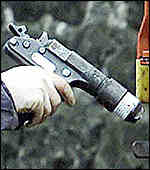 Bolt guns are in short supply |
But my men all live in town, and have it in their contracts that they'll not come into contact with healthy livestock. They also have to keep away from anyone they know with livestock.
They're working 10 to 12-hour days. On one farm, there might be 450 cattle and 1,500 sheep, which take a day or a day-and-a-half to kill, whereas on another farm, there might only be seven cows.
The slaughterers have to disinfect their boots and protective gear after each cull.
To prevent spreading the virus on their vehicles, they park outside the property and go the last hundred metres on foot.
Making progress
Up until now, we've been following in the wake of the disease, rather than getting in front of it.
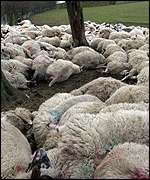 Up to half a million sheep will be buried |
The system works like this: when the vet confirms a case of foot-and-mouth, the farmer gets a valuer in to work out the full market value of the herd for compensation. Only then do the slaughtermen come in.
At first, there was such a backlog of cases that it took us four, five or sometimes six days to get to a farm.
Now, we're just about caught up with the valuers - sometimes they're still on the farm when my guys arrive. And the case has usually been confirmed the day before.
Taking action
I think all livestock within a 10-mile radius of a confirmed case should be vaccinated, to create a firewall to contain the disease.
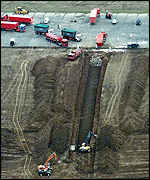 Cumbria has been hard-hit by the outbreak |
And I've been saying for a while that there should be a central disposal point for the carcasses. Airfields are ideal because they've already got roads leading to them.
Then last week, I got a phone call from the Maff vet, asking about using my airfield for burials.
Maff wanted to commandeer the block of land for 12 months, and offered me compensation for losing the use of the land and the cost of recovery when the year is out.
I'm keeping well away from the airfield. I don't want to have to go there and I don't want to have to get dressed in protective gear.
Out of control
A couple of weeks ago, it looked as if the foot-and-mouth crisis would be over within three or four months.
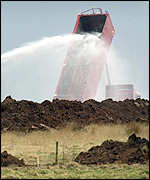 Disinfecting a truckload of carcasses |
But now, I don't know if there's any point reopening my abattoir if everything is going to be slaughtered within 20 or 30 miles of us.
I run a small, rural operation, and under normal circumstances, 90% of what we slaughter comes from the markets nearby.
If they've got nothing to sell, what's the point of opening again? ![]()